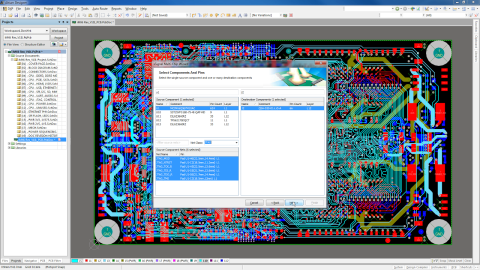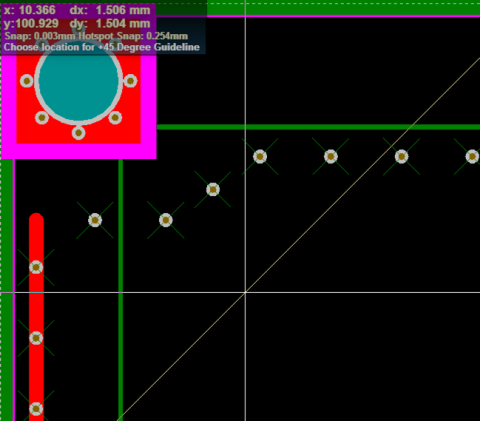Transmission Line Delay Calculators in PCB Design
Transmission lines are one of those deceptively complex things that make modern life possible. What seems like a simple metal cable is, in fact, a precisely engineered system. Traces on PCBs are no different, and they are like the blood vessels that power your electronic devices.
So what is a transmission line anyway? This term was initially adopted to create the analogy between traces on a PCB and civilian power lines. The term “transmission line” tends to get thrown about without much context. Not all traces on a PCB are transmission lines, and design rules for transmission line become important in some cases.
Are My Traces Transmission Lines?
The term “transmission line” refers to the behavior of a trace on a PCB rather than its construction. A given trace may behave as a transmission line under some conditions while behaving as a simple conductor in other conditions.
The answer to whether your traces act like transmission lines depends on the amount of time it takes a signal to propagate down the trace. This time has been referred to as line delay, propagation delay, or transmission delay, and all of these terms are used interchangeably.
If the line delay in your trace is much longer than the rise time of a digital signal traveling on the trace, then the trace will act like a transmission line. With analog signals, the rise time is taken to be one-quarter of the signal’s oscillation period. In both cases, traces and components at each end need to be impedance matched to prevent various signal integrity problems.
Electric transmission lines
Online Transmission Line Calculators
If you want a quick and dirty way to design your traces to have a specific impedance value, you can use an online transmission line calculator. This tool can calculate several critical parameters like unit length that describe your traces for different arrangements, including microstrips, embedded microstrips, and stripline traces.
One thing you will begin to notice is that most online transmission line calculators completely ignore the frequency dependence of the transmission line impedance. In reality, there is an effect due to frequency, and the effect is more pronounced depending on the resistance, capacitance, inductance, and conductance in the system.
The impedance encountered by lower frequency signals tends to be more sensitive to frequency changes than the impedance at high frequencies. Some online transmission line calculators do not always allow you to explore the impedance at low frequencies and they generally assume you are working at high frequency.
At very high frequencies, like those used in RF applications, this frequency dependence saturates to a constant value. As such, most online calculators assume you’re working at a high enough frequency that this dependence can be ignored.
An important output from a transmission line calculator is the effective dielectric constant. This parameter depends on the dimensions of the trace, as well as the contrast between the conductor and substrate dielectric constants. This parameter plays the same role as an effective refractive index in fiber optics in that it determines how fast a signal propagates down the transmission line.
This is where online transmission line calculators are also useful. Once you have your effective dielectric constant, you can use it to calculate the line delay in your traces. After calculating the line delay and comparing it with your signal rise time, you will have your answer as to whether your traces are actually behaving as transmission lines.
Electronics design with a calculator
SPICE Simulations and Transmission Lines
SPICE simulators are useful for examining signal integrity issues in PCBs, especially in high speed, high frequency, HDI, and low current applications. Not all SPICE simulations will return the impedance value of your transmission lines directly; they will allow you diagnose signal integrity problems that can arise from impedance mismatch between traces and components. Online and desktop design software packages give you access to SPICE simulations.
All PCBs have some parasitic capacitance and inductance due to the separation of metallic elements by the substrate dielectric. When working with a SPICE simulation, the effects of parasitic impedance have to be modeled by adding capacitors and inductors in series and shunt positions in your equivalent circuit model.
A typical SPICE simulation does not include this directly, and you would have to add inductors and capacitors at strategic points to take account of parasitic reactance. More advanced SPICE simulators take this into account directly. You parasitic capacitance and inductance can be calculated directly from the dielectric constant of the PCB substrate and the arrangement of conductors on the board.
The output from a good SPICE model is instrumental because it allows you to visualize problems like ringing, ground bounce, signal mismatch due to propagation delay, and even noise coupling. Diagnosing these signal problems before manufacturing can help you avoid ordering a batch of defective boards.
This output is generally displayed on a graph of voltage (or current) versus time. This type of output lets you compare the input and output signal strengths, propagation delay, and signal integrity. When working in the frequency domain, you can see the transfer function that defines the relationship between input and output signals.
Altium Designer® has simulation tools and operates in a rules-driven design environment that can help you avoid and diagnose signal integrity problems. Now you can download a free trial and find out if Altium is right for you. Talk to an Altium expert today if you want to learn more.











 Back
Back